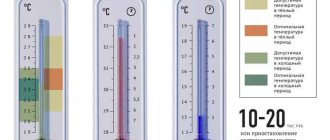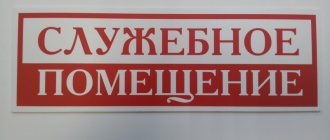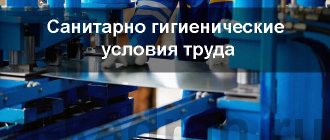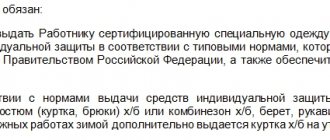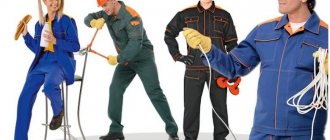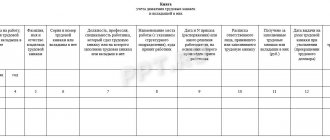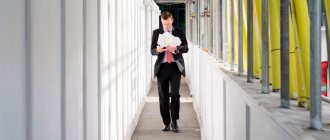Hygienic requirements for the microclimate of industrial premises are strictly regulated at the legislative level. Microclimate refers to a complex of physical factors that influence the body’s heat exchange, human health and well-being. These factors also affect performance and productivity. In this regard, for every employer, creating an optimal microclimate in production premises is a priority task.
The microclimate parameters of the production facility are divided into 2 groups:
- Optimal - provide comfortable working conditions and create the prerequisites for increasing performance, do not have a harmful effect on the human body.
- Acceptable – with prolonged exposure to such parameters on the body, a person’s well-being worsens and a feeling of discomfort arises. Acceptable parameters are established at workplaces where, for various reasons, it is impossible to create optimal conditions for workers.
Basic conditions
From the beginning of 2021, new sanitary and hygienic requirements for production premises have come into force. They were approved by the Chief State Sanitary Doctor by his Resolution No. 81 on June 21 last year. The updated SanPiN standards put forward requirements for:
- Microclimate;
- Noise and vibration levels;
- Exposure to electric, magnetic and electromagnetic fields.
These norms are marginally possible indicators of factors. Compliance with the requirements for production premises can protect employees who are at the workplace eight hours a day (forty hours a week) from the development of pathologies or occupational diseases associated with the specific performance of work duties.
The introduction of new hygienic requirements for the microclimate of industrial premises cancels the previously approved standards. For example, SanPiN 2.2.41191-03 regarding the effects of electromagnetic fields.
The most important issues regulated by SanPiNs are temperature and microclimate in the workplace of office employees.
Terms and Definitions
3.1. Industrial premises are enclosed spaces in specially designed buildings and structures in which people’s labor activities are carried out constantly (in shifts) or periodically (during the working day).
3.2. Workplace is an area of the premises where labor activity is carried out during a work shift or part of it. A workplace can be several areas of a production facility. If these areas are located throughout the room, then the entire area of the room is considered a workplace.
3.3. The cold period of the year is a period of the year characterized by an average daily outside air temperature of +10 °C and below.
3.4. The warm period of the year is a period of the year characterized by an average daily outdoor temperature above +10 °C.
3.5. Average daily outside air temperature is the average outside air temperature measured at certain hours of the day at regular intervals. It is taken according to the meteorological service.
3.6. The division of work into categories is carried out on the basis of the intensity of the body's total energy expenditure in kcal/h (W). Characteristics of individual categories of work (Ia, Ib, IIa, IIb, III) are presented in Appendix 1.
3.7. Thermal load of the environment (THL) is the combined effect of microclimate parameters (temperature, humidity, air speed, thermal radiation) on the human body, expressed as a single-digit indicator in °C.
Temperature in the office
Maintaining normal temperature is an important condition for the normal functioning of the company. Not only the health of workers, but also their labor productivity, as well as the normal functioning of the entire enterprise, depends on the temperature in the office.
Temperature standards are regulated by SanPin 2.2.4 548 96. The fifth and sixth sections of the Rules are devoted to optimization and temperature limits depending on the season (warm or cold).
Office workers whose work can be classified as intellectual, characterized by a low level of physical activity, as well as a sedentary position, are included in category Ia by the Labor Code and SanPin. For this category of employees, a temperature of twenty-three to twenty-five degrees (in summer) and twenty-two to twenty-four degrees (in winter) must be provided.
If the room temperature does not meet the specified standards, employees have the right to demand that the employer reduce the duration of work shifts.
If the temperature exceeds plus twenty-nine, labor time is reduced to three to six hours (in accordance with the functions performed). If the temperature in the office exceeds thirty-two degrees, working for more than one hour is prohibited.
There are indicators for the cold season. At temperatures below nineteen degrees, the shift duration is reduced by an hour. At temperatures below thirteen degrees Celsius, the working day cannot exceed one hour.
The work of an organization whose management constantly violates the temperature conditions of the premises can be temporarily stopped for a period of up to three months.
Legislative framework of the Russian Federation
valid Editorial from 01.01.1970
detailed information
| Name of document | “HYGIENIC REQUIREMENTS FOR THE MICROCLIMATE OF PRODUCTION PREMISES. SANITARY RULES AND STANDARDS. SanPiN 2.2.4.548-96" (approved by Resolution of the State Committee for Sanitary and Epidemiological Supervision of the Russian Federation dated 01.10.96 N 21) |
| Document type | decree, rules |
| Receiving authority | State Committee for Sanitary and Epidemiological Surveillance of the Russian Federation |
| Document Number | 21 |
| Acceptance date | 01.01.1970 |
| Revision date | 01.01.1970 |
| Date of registration with the Ministry of Justice | 01.01.1970 |
| Status | valid |
| Publication |
|
| Navigator | Notes |
“HYGIENIC REQUIREMENTS FOR THE MICROCLIMATE OF PRODUCTION PREMISES. SANITARY RULES AND STANDARDS. SanPiN 2.2.4.548-96" (approved by Resolution of the State Committee for Sanitary and Epidemiological Supervision of the Russian Federation dated 01.10.96 N 21)
Approved
by Resolution of the State Committee for Sanitary and Epidemiological Surveillance of Russia dated October 1, 1996 No. 21
Date of introduction - from the moment
of approval
HYGIENIC REQUIREMENTS FOR THE MICROCLIMATE OF INDUSTRIAL PREMISES1. General provisions and scope
1.1. These sanitary rules and regulations (hereinafter referred to as the Sanitary Rules) are intended to prevent the adverse effects of the microclimate of workplaces and industrial premises on the well-being, functional state, performance and health of a person.
1.2. These Sanitary Rules apply to microclimate indicators in workplaces of all types of industrial premises and are mandatory for all enterprises and organizations. References to the mandatory compliance with the requirements of these Sanitary Rules must be included in regulatory and technical documents: standards, building codes and regulations, technical specifications and other regulatory and technical documents regulating the operational characteristics of production facilities, technological, engineering and sanitary equipment that provide hygienic microclimate standards.
1.3. In accordance with the articles of the RSFSR Law “On the Sanitary and Epidemiological Welfare of the Population,” organizations must exercise production control over compliance with the requirements of the Sanitary Rules and carry out preventive measures aimed at preventing the occurrence of diseases of workers in production premises, as well as monitoring compliance with working and rest conditions and implementation of measures for collective and individual protection of workers from the adverse effects of the microclimate.
1.4. Heads of enterprises, organizations and institutions, regardless of their form of ownership and subordination, in order to ensure production control, are obliged to bring workplaces into compliance with the microclimate requirements provided for by these Sanitary Rules.
1.5. State sanitary and epidemiological supervision and control over the implementation of these Sanitary Rules is carried out by bodies and institutions of the State Sanitary and Epidemiological Service of the Russian Federation, and departmental sanitary and epidemiological supervision and control is carried out by bodies and institutions of the sanitary and epidemiological profile of the relevant ministries and departments.
1.6. State sanitary and epidemiological supervision over the construction of new and reconstruction of existing production facilities is carried out at the stages of project development and commissioning of facilities, taking into account the nature of the technological process and the compliance of engineering and sanitary equipment with the requirements of these Sanitary Rules and Building Codes “Heating, Ventilation and conditioning".
1.7. Project documentation for the construction and reconstruction of industrial premises must be agreed upon with the bodies and institutions of the State Sanitary and Epidemiological Service of Russia.
1.8. The commissioning of production premises in order to assess the compliance of the hygienic parameters of the microclimate with the requirements of these Sanitary Rules must be carried out with the mandatory participation of representatives of the State Sanitary and Epidemiological Surveillance of the Russian Federation.
2. Normative references
2.1. Law of the RSFSR “On the sanitary and epidemiological welfare of the population.”
2.2. Regulations on the State Sanitary and Epidemiological Service of the Russian Federation and Regulations on State Sanitary and Epidemiological Standards, approved by Decree of the Government of the Russian Federation of June 5, 1994 N 625.
2.3. Guidelines “General requirements for the construction, presentation and execution of sanitary-hygienic and epidemiological normative and methodological documents” dated February 9, 1994 R1.1.004-94.
3. Terms and definitions
3.1. Industrial premises are enclosed spaces in specially designed buildings and structures in which people’s labor activities are carried out constantly (in shifts) or periodically (during the working day).
3.2. Workplace is an area of the premises where labor activity is carried out during a work shift or part of it. A workplace can be several areas of a production facility. If these areas are located throughout the room, then the entire area of the room is considered a workplace.
3.3. The cold period of the year is a period of the year characterized by an average daily outside air temperature of +10° C and below.
3.4. The warm period of the year is a period of the year characterized by an average daily outdoor temperature above +10° C.
3.5. Average daily outside air temperature is the average outside air temperature measured at certain hours of the day at regular intervals. It is taken according to the meteorological service.
3.6. The division of work into categories is carried out on the basis of the intensity of the body's total energy expenditure in kcal/h (W). Characteristics of individual categories of work (Ia, Ib, IIa, IIb, III) are presented in Appendix 1.
3.7. Thermal load of the environment (THL) is the combined effect of microclimate parameters (temperature, humidity, air speed, thermal radiation) on the human body, expressed as a single-digit indicator in °C.
4. General requirements and microclimate indicators
4.1. Sanitary rules establish hygienic requirements for microclimate indicators of workplaces in industrial premises, taking into account the intensity of energy consumption of workers, time of work, periods of the year and contain requirements for methods of measuring and monitoring microclimatic conditions.
4.2. Microclimate indicators must ensure the preservation of the thermal balance of a person with the environment and the maintenance of an optimal or acceptable thermal state of the body.
4.3. Indicators characterizing the microclimate in production premises are:
- air temperature;
— surface temperature <*>;
- relative humidity;
— air speed;
— intensity of thermal radiation.
<*> The temperature of the surfaces of enclosing structures (walls, ceilings, floors), devices (screens, etc.), as well as technological equipment or devices enclosing it, is taken into account.
5. Optimal microclimate conditions
5.1. Optimal microclimatic conditions are established according to the criteria of the optimal thermal and functional state of a person. They provide a general and local feeling of thermal comfort during an 8-hour work shift with minimal stress on the thermoregulation mechanisms, do not cause deviations in health, create the prerequisites for a high level of performance and are preferred in the workplace.
5.2. Optimal values of microclimate indicators must be observed at workplaces of industrial premises where operator-type work associated with nervous and emotional stress is performed (in cabins, at consoles and control stations for technological processes, in computer rooms, etc.). The list of other workplaces and types of work in which optimal microclimate values must be ensured is determined by the Sanitary Rules for individual industries and other documents agreed upon with the State Sanitary and Epidemiological Supervision authorities in the prescribed manner.
5.3. The optimal microclimate parameters at workplaces should correspond to the values given in table. 1, in relation to the performance of work of various categories in the cold and warm periods of the year.
5.4. Changes in air temperature in height and horizontally, as well as changes in air temperature during a shift, while ensuring optimal microclimate values in the workplace, should not exceed 2 ° C and go beyond the values specified in the table. 1 for certain categories of work.
Table 1
OPTIMUM VALUES OF MICROCLIMATE INDICATORS AT WORKPLACES IN PRODUCTION PREMISES
| Period of the year | Category of work by energy consumption levels, W | Air temperature, °C | Surface temperature, °C | Relative humidity, % | Air speed, m/s |
| Cold | Ia (up to 139) | 22 — 24 | 21 — 25 | 60 — 40 | 0,1 |
| Ib (140 - 174) | 21 — 23 | 20 — 24 | 60 — 40 | 0,1 | |
| IIa (175 - 232) | 19 — 21 | 18 — 22 | 60 — 40 | 0,2 | |
| IIb (233 - 290) | 17 — 19 | 16 — 20 | 60 — 40 | 0,2 | |
| III (over 290) | 16 — 18 | 15 — 19 | 60 — 40 | 0,3 | |
| Warm | Ia (up to 139) | 23 — 25 | 22 — 26 | 60 — 40 | 0,1 |
| Ib (140 - 174) | 22 — 24 | 21 — 25 | 60 — 40 | 0,1 | |
| IIa (175 - 232) | 20 — 22 | 19 — 23 | 60 — 40 | 0,2 | |
| IIb (233 - 290) | 19 — 21 | 18 — 22 | 60 — 40 | 0,2 | |
| III (over 290) | 18 — 20 | 17 — 21 | 60 — 40 | 0,3 |
6. Acceptable microclimate conditions
6.1. Acceptable microclimatic conditions are established according to the criteria for the permissible thermal and functional state of a person for the period of an 8-hour work shift. They do not cause damage or health problems, but can lead to general and local sensations of thermal discomfort, tension in the thermoregulatory mechanisms, deterioration of well-being and decreased performance.
6.2. Acceptable values of microclimate indicators are established in cases where, due to technological requirements, technical and economically justified reasons, optimal values cannot be ensured.
6.3. Acceptable values of microclimate indicators at workplaces must correspond to the values given in table. 2 in relation to the performance of work of various categories in the cold and warm periods of the year.
6.4. When ensuring acceptable microclimate values at workplaces:
— the difference in air temperature in height should be no more than 3° C;
— the horizontal air temperature difference, as well as its changes during the shift, should not exceed:
for work categories Ia and Ib - 4° C;
for work categories IIa and IIb - 5° C;
for work category III - 6° C.
In this case, the absolute values of the air temperature should not go beyond the values indicated in the table. 2 for certain categories of work.
6.5. When the air temperature in the workplace is 25° C and above, the maximum permissible values of relative air humidity should not exceed the following limits:
70% - at an air temperature of 25° C;
65% - at an air temperature of 26° C;
60% - at an air temperature of 27° C;
55% - at an air temperature of 28° C.
6.6. At an air temperature of 26 - 28 ° C, the air speed indicated in the table. 2 for the warm period of the year, must correspond to the range:
0.1 - 0.2 m/s - for work category Ia;
0.1 - 0.3 m/s - for work category Ib;
0.2 - 0.4 m/s - for work category IIa;
0.2 - 0.5 m/s - for work categories IIb and III.
table 2
ALLOWABLE VALUES FOR MICROCLIMATE INDICATORS AT WORKPLACES AND PRODUCTION PREMISES
| Period of the year | Category of work by level of energy consumption, W | Air temperature, °C | Surface temperature, °C | Relative humidity, % | Air speed, m/s | ||
| range below optimal values | range above optimal values | for a range of air temperatures below optimal values, no more | for a range of air temperatures above optimal values, no more than <**> | ||||
| Cold | Ia (up to 139) | 20,0 — 21,9 | 24,1 — 25,0 | 19,0 — 26,0 | 15 — 75 <*> | 0,1 | 0,1 |
| Ib (140 - 174) | 19,0 — 20,9 | 23,1 — 24,0 | 18,0 — 25,0 | 15 — 75 | 0,1 | 0,2 | |
| IIa (175 - 232) | 17,0 — 18,9 | 21,1 — 23,0 | 16,0 — 24,0 | 15 — 75 | 0,1 | 0,3 | |
| IIb (233 - 290) | 15,0 — 16,9 | 19,1 — 22,0 | 14,0 — 23,0 | 15 — 75 | 0,2 | 0,4 | |
| III (over 290) | 13,0 — 15,9 | 18,1 — 21,0 | 12,0 — 22,0 | 15 — 75 | 0,2 | 0,4 | |
| Warm | Ia (up to 139) | 21,0 — 22,9 | 25,1 — 28,0 | 20,0 — 29,0 | 15 — 75 <*> | 0,1 | 0,2 |
| Ib (140 - 174) | 20,0 — 21,9 | 24,1 — 28,0 | 19,0 — 29,0 | 15 — 75 <*> | 0,1 | 0,3 | |
| IIa (175 - 232) | 18,0 — 19,9 | 22,1 — 27,0 | 17,0 — 28,0 | 15 — 75 <*> | 0,1 | 0,4 | |
| IIb (233 - 290) | 16,0 — 18,9 | 21,1 — 27,0 | 15,0 — 28,0 | 15 — 75 <*> | 0,2 | 0,5 | |
| III (over 290) | 15,0 — 17,9 | 20,1 — 26,0 | 14,0 — 27,0 | 15 — 75 <*> | 0,2 | 0,5 | |
<*> At air temperatures of 25° C and above, the maximum values of relative air humidity must be taken in accordance with the requirements of clause 6.5.
<**> At air temperatures of 26 - 28 ° C, the speed of air movement in the warm season should be taken in accordance with the requirements of clause 6.6.
6.7. Permissible values of the intensity of thermal radiation of workers in the workplace from production sources heated to a dark glow (materials, products, etc.) must correspond to the values given in Table. 3.
Table 3
ALLOWABLE VALUES OF THE INTENSITY OF THERMAL IRRADIATION OF THE BODY SURFACE OF WORKING FROM INDUSTRIAL SOURCES
| Irradiated body surface, % | Thermal irradiation intensity, W/sq. m, no more |
| 50 or more | 35 |
| 25 — 50 | 70 |
| no more than 25 | 100 |
6.8. The permissible values of the intensity of thermal radiation working from radiation sources heated to a white and red glow (hot or molten metal, glass, flame, etc.) should not exceed 140 W/sq. m. In this case, more than 25% of the body surface should not be exposed to irradiation, and the use of personal protective equipment, including face and eye protection, is mandatory.
6.9. In the presence of thermal radiation of workers, the air temperature in the workplace should not exceed the following values, depending on the category of work:
25° C - for work category Ia;
24° C - for work category Ib;
22° C - for work category IIa;
21° C - for work category IIb;
20° C - for work category III.
6.10. In industrial premises in which permissible standard values for microclimate indicators cannot be established due to technological requirements for the production process or economically justified inexpediency, microclimate conditions should be considered harmful and dangerous. In order to prevent the adverse effects of the microclimate, protective measures should be used (for example, local air conditioning systems, air showers, compensation for the adverse effects of one microclimate parameter by changing another, special clothing and other personal protective equipment, rooms for rest and heating, regulation of work hours, in particular , breaks in work, reduction of working hours, increase in vacation duration, decrease in length of service, etc.).
6.11. To assess the combined impact of microclimate parameters in order to implement measures to protect workers from possible overheating, it is recommended to use the integral indicator of the thermal load of the environment (THL), the values of which are given in Table. 1 Appendix 2.
6.12. To regulate the working time within a work shift in microclimate conditions with air temperatures at workplaces higher or lower than permissible values, it is recommended to follow the table. 1 and 2 of Appendix 3.
7. Requirements for the organization of control and methods for measuring microclimate
7.1. Measurements of microclimate indicators in order to monitor their compliance with hygienic requirements should be carried out during the cold period of the year - on days with outside air temperatures differing from the average temperature of the coldest month of winter by no more than 5 ° C, in the warm period of the year - on days with outside temperatures air, differing from the average maximum temperature of the hottest month by no more than 5° C. The frequency of measurements in both periods of the year is determined by the stability of the production process, the functioning of technological and sanitary equipment.
7.2. When choosing areas and measurement times, it is necessary to take into account all factors affecting the microclimate of workplaces (phases of the technological process, functioning of ventilation and heating systems, etc.). Measurements of microclimate indicators should be carried out at least 3 times per shift (at the beginning, middle and end). In case of fluctuations in microclimate parameters associated with technological and other reasons, it is necessary to carry out additional measurements at the highest and lowest values of thermal loads on workers.
7.3. Measurements should be carried out at workplaces. If the workplace consists of several sections of the production premises, then measurements are carried out at each of them.
7.4. If there are sources of local heat release, cooling or moisture release (heated units, windows, doorways, gates, open bathtubs, etc.), measurements should be carried out at each workplace at points minimally and maximally distant from sources of thermal influence.
7.5. In rooms with a high density of workplaces, in the absence of sources of local heat generation, cooling or moisture release, areas for measuring temperature, relative humidity and air velocity should be distributed evenly over the area of the room in accordance with Table. 4.
Table 4
MINIMUM NUMBER OF AREAS FOR MEASURING TEMPERATURE, RELATIVE HUMIDITY AND AIR SPEED
| Room area, sq. m | Number of measuring sites |
| Up to 100 | 4 |
| From 100 to 400 | 8 |
| Over 400 | The number of sections is determined by the distance between them, which should not exceed 10 m |
7.6. When working while sitting, the temperature and speed of air movement should be measured at a height of 0.1 and 1.0 m, and the relative humidity of the air - at a height of 1.0 m from the floor or working platform. When working while standing, the temperature and air velocity should be measured at a height of 0.1 and 1.5 m, and the relative humidity at a height of 1.5 m.
7.7. In the presence of radiant heat sources, thermal exposure in the workplace must be measured from each source, placing the instrument receiver perpendicular to the incident flux. Measurements should be taken at a height of 0.5; 1.0 and 1.5 m from the floor or working platform.
7.8. The temperature of surfaces should be measured in cases where workplaces are no more than two meters away from them. The temperature of each surface is measured in the same way as measuring air temperature according to clause 7.6.
7.9. Temperature and relative humidity in the presence of sources of thermal radiation and air currents in the workplace should be measured using aspiration psychrometers. In the absence of radiant heat and air flows in the measurement areas, the temperature and relative humidity of the air can be measured with psychrometers that are not protected from the effects of thermal radiation and air velocity. Instruments that allow you to separately measure temperature and air humidity can also be used.
7.10. The speed of air movement should be measured with rotational anemometers (vane, cup, etc.). Small values of air velocity (less than 0.5 m/s), especially in the presence of multidirectional flows, can be measured with thermoelectric anemometers, as well as cylindrical and ball catathermometers, if they are protected from thermal radiation.
7.11. The temperature of surfaces should be measured with contact devices (such as electric thermometers) or remote ones (pyrometers, etc.).
7.12. The intensity of thermal radiation should be measured with instruments that provide a sensor viewing angle close to a hemisphere (at least 160°) and are sensitive in the infrared and visible regions of the spectrum (actinometers, radiometers, etc.).
7.13. The measuring range and permissible error of measuring instruments must comply with the requirements of table. 5.
7.14. Based on the results of the study, it is necessary to draw up a protocol, which should reflect general information about the production facility, the placement of technological and sanitary equipment, sources of heat generation, cooling and moisture release, a diagram of the location of areas for measuring microclimate parameters and other data.
7.15. At the conclusion of the protocol, the results of the measurements performed must be assessed for compliance with regulatory requirements.
Table 5
REQUIREMENTS FOR MEASURING INSTRUMENTS
| Indicator name | measurement range | Maximum deviation |
| Dry bulb air temperature, °C | from -30 to 50 | +/- 0,2 |
| Wet bulb air temperature, °C | from 0 to 50 | +/- 0,2 |
| Surface temperature, °C | from 0 to 50 | +/- 0,5 |
| Relative humidity, % | from 0 to 90 | +/- 5,0 |
| Air speed, m/s | from 0 to 0.5 more than 0.5 | +/- 0,05 +/- 0,1 |
| Thermal irradiation intensity, W/sq. m | from 10 to 350 more than 350 | +/- 5,0 +/- 50,0 |
Applications
Appendix 1
(for reference)
CHARACTERISTICS OF SEPARATE CATEGORIES OF WORK
1. Categories of work are delimited based on the intensity of the body’s energy expenditure in kcal/h (W).
2. Category Ia includes work with an energy intensity of up to 120 kcal/h (up to 139 W), performed while sitting and accompanied by minor physical stress (a number of professions in precision instrumentation and mechanical engineering enterprises, watchmaking, clothing production, management, etc. .P.).
3. Category Ib includes work with an energy intensity of 121 - 150 kcal/h (140 - 174 W), performed while sitting, standing or associated with walking and accompanied by some physical stress (a number of professions in the printing industry, communications enterprises, controllers, foremen in various types of production, etc.).
4. Category IIa includes work with an energy intensity of 151 - 200 kcal/h (175 - 232 W), associated with constant walking, moving small (up to 1 kg) products or objects in a standing or sitting position and requiring a certain physical exertion (a number professions in mechanical assembly shops of machine-building enterprises, in spinning and weaving production, etc.).
5. Category IIb includes work with an energy intensity of 201 - 250 kcal/h (233 - 290 W), associated with walking, moving and carrying weights up to 10 kg and accompanied by moderate physical stress (a number of professions in mechanized foundries, rolling, forging, thermal, welding shops of machine-building and metallurgical enterprises, etc.).
6. Category III includes work with an energy intensity of more than 250 kcal/h (more than 290 W), associated with constant movement, movement and carrying of significant (over 10 kg) weights and requiring great physical effort (a number of professions in forge shops with hand forging , foundries with manual filling and pouring of flasks of machine-building and metallurgical enterprises, etc.).
Appendix 2
(recommended)
DETERMINATION OF THE THERMAL LOAD INDEX OF THE ENVIRONMENT (THN-INDEX)
1. The environmental heat load index (THI) is an empirical indicator characterizing the combined effect of microclimate parameters (temperature, humidity, air speed and thermal radiation) on the human body.
2. The THC index is determined based on the temperature of the wet bulb of an aspiration psychrometer (tvl.) and the temperature inside the blackened ball (tsh).
3. The temperature inside the blackened ball is measured by a thermometer, the reservoir of which is placed in the center of the blackened hollow ball; tsh reflects the influence of air temperature, surface temperature and air speed. The blackened ball must have a diameter of 90 mm, the minimum possible thickness and an absorption coefficient of 0.95. The accuracy of measuring the temperature inside the ball is +/- 0.5° C.
4. TNS index is calculated using the equation:
THC = 0.7 x tvl. + 0.3 x tsh.
5. The THC index is recommended to be used for an integral assessment of the thermal load of the environment in workplaces where the air speed does not exceed 0.6 m/s and the intensity of thermal radiation is 1200 W/sq. m.
6. The method for measuring and monitoring the THC index is similar to the method for measuring and monitoring air temperature (clauses 7.1 - 7.6 of these Sanitary Rules).
7. The values of the TNS index should not go beyond the values recommended in the table. 1.
Table 1
RECOMMENDED VALUES OF THE INTEGRAL INDICATOR OF THE HEAT LOAD OF THE ENVIRONMENT (THN-INDEX) TO PREVENT OVERHEATING OF THE ORGANISM
| Category of work by energy consumption level | Integral index values, °C |
| Ia (up to 139) | 22,2 — 26,4 |
| Ib (140 - 174) | 21,5 — 25,8 |
| IIa (175 - 232) | 20,5 — 25,1 |
| IIb (233 - 290) | 19,5 — 23,9 |
| III (over 290) | 18,0 — 21,8 |
Appendix 3
(recommended)
OPERATING TIME WHEN THE AIR TEMPERATURE AT THE WORKPLACE IS ABOVE OR BELOW PERMITTED VALUES
1. In order to protect workers from possible overheating or cooling, when the air temperature in the workplace is higher or lower than permissible values, the time spent at the workplace (continuously or cumulatively for a work shift) should be limited to the values specified in table. 1 and table. 2 of this Appendix. At the same time, the average shift air temperature at which workers are located during a work shift at workplaces and rest areas should not go beyond the permissible air temperature values for the corresponding categories of work indicated in Table. 2 of these Sanitary Rules.
Table 1
TIME OF STAY AT WORKPLACES AT AIR TEMPERATURES ABOVE PERMITTED VALUES
| Air temperature at the workplace, °C | Stay time, no more, for categories of work, hours | ||
| Ia - Ib | IIa - IIb | III | |
| 32,5 | 1 | — | — |
| 32,0 | 2 | — | — |
| 31,5 | 2,5 | 1 | — |
| 31,0 | 3 | 2 | — |
| 30,5 | 4 | 2,5 | 1 |
| 30,0 | 5 | 3 | 2 |
| 29,5 | 5,5 | 4 | 2,5 |
| 29,0 | 6 | 5 | 3 |
| 28,5 | 7 | 5,5 | 4 |
| 28,0 | 8 | 6 | 5 |
| 27,5 | — | 7 | 5,5 |
| 27,0 | — | 8 | 6 |
| 26,5 | — | — | 7 |
| 26,0 | — | — | 8 |
table 2
TIME OF STAY AT WORKPLACES AT AIR TEMPERATURES BELOW ALLOWABLE VALUES
| Air temperature at the workplace, °C | Stay time, no more, for categories of work, hours | ||||
| Ia | Ib | IIa | IIb | III | |
| 6 | — | — | — | — | 1 |
| 7 | — | — | — | — | 2 |
| 8 | — | — | — | 1 | 3 |
| 9 | — | — | — | 2 | 4 |
| 10 | — | — | 1 | 3 | 5 |
| 11 | — | — | 2 | 4 | 6 |
| 12 | — | 1 | 3 | 5 | 7 |
| 13 | 1 | 2 | 4 | 6 | 8 |
| 14 | 2 | 3 | 5 | 7 | — |
| 15 | 3 | 4 | 6 | 8 | — |
| 16 | 4 | 5 | 7 | — | — |
| 17 | 5 | 6 | 8 | — | — |
| 18 | 6 | 7 | — | — | — |
| 19 | 7 | 8 | — | — | — |
| 20 | 8 | — | — | — | — |
Shift average air temperature (tb) is calculated using the formula:
| _ tв = | tв1 x r1 + tв2 x r2 + … + tвn x rn | , Where |
| 8 |
tв1, tв2 … tвn — air temperature (°C) in the corresponding areas of the workplace;
r1, r2, … rn — time (hours) for performing work in the corresponding areas of the workplace;
8 — duration of work shift (hours).
Other indicators of the microclimate (relative air humidity, air speed, surface temperature, intensity of thermal radiation) at workplaces must be within the permissible values of these Sanitary Rules.
BIBLIOGRAPHICAL DATA
1. Guide R 2.2.4/2.1.8. Hygienic assessment and control of physical factors of production and the environment (under approval).
2. Building codes and regulations. SNiP 2.01.01. "Building climatology and geophysics."
3. Methodological recommendations “Assessment of a person’s thermal state in order to substantiate hygienic requirements for the microclimate of workplaces and measures to prevent cooling and overheating” N 5168-90 dated 03/05/90. In: Hygienic principles for preventing the adverse effects of industrial microclimate on the human body. V. 43. M., 1991, p. 192 - 211.
4. Guide R 2.2.013-94. Occupational hygiene. Hygienic criteria for assessing working conditions in terms of harmfulness and danger of factors in the working environment, severity and intensity of the labor process. Goskomsanepidnadzor of Russia, M., 1994, 42 p.
5. GOST 12.1.005-88 “General sanitary and hygienic requirements for air in the working area.”
6. Building codes and regulations. SNiP 2.04.95-91 “Heating, ventilation and air conditioning”.
Requirements for the microclimate in the office
Sanitary rules include requirements not only for temperature conditions, but also for air quality in the office. Therefore, the ventilation equipment of an organization is one of the significant criteria for the comfort of workplaces.
Office service requires workers to remain in the building for a long time. Each employee has his own preferences and needs to improve productivity. Some prefer coolness, others are afraid of drafts and air conditioning.
To create a comfortable office microclimate, a set of measures is required to meet the standards:
- Temperature conditions;
- Air humidity level;
- Ventilation of air flows;
- Air circulation speeds;
- The presence of foreign particles (dust) in the air.
These standards are provided for by SanPin, as well as GOST 30494 96 regarding the microclimate parameters of residential and non-residential premises. A comfortable office microclimate in the warm season includes:
- Temperature range between twenty-two and twenty-five degrees;
- Air humidity thirty to sixty percent;
- The air flow speed is not higher than 0.25 meters per second.
For the cold season, the indicators change:
- Temperatures range from twenty to twenty-two degrees;
- Air humidity - from thirty to forty-five percent;
- Air movement is 0.1 - 0.15 meters per second.
Acceptable temperature differences are one to two degrees.
Moisture level is a necessary component of comfortable work for office workers. What humidity should be directly depends on the temperature conditions of the room. High humidity at normal temperatures does not have a negative effect on the human body. And dry warm air can cause diseases of the mucous membranes and upper respiratory tract.
Main SanPiN indicators for the microclimate of industrial premises (new)
Temperature is a thermodynamic parameter that characterizes the state of the atmosphere. If the temperature in the room exceeds the approved parameters, workers quickly get tired, their attention decreases and their performance decreases. Exposure to low temperatures leads to hypothermia of the body, which causes various diseases (including frostbite of parts of the body). We discussed temperature standards in the workplace in detail here.
Relative air humidity is a parameter characterizing the proportion of water content in the air. When humidity is high, the body's thermoregulation is disrupted; when humidity is low, heat transfer accelerates and the mucous membranes of the upper respiratory tract dry out.
Air speed is the distance that an air mass travels per unit time. This parameter affects the thermal balance of the body; it determines the level of heat transfer through convection and evaporation. The high speed of movement of air masses contributes to the occurrence of drafts, which leads to deterioration in the health of workers (colds, sciatica, etc. may occur).
Thermal radiation - emitted by bodies due to their internal energy, caused by the movement of atoms or molecules of the emitting body. Radiation is characterized by different lengths of infrared waves. In production, sources of thermal radiation are heating furnaces, thermal and hardening baths, welding equipment, etc.
Light level
Office lighting is an important component that employers should not forget about. Low light levels lead to rapid eye fatigue and also reduce a person’s overall performance.
SanPin sets lighting standards for an average office containing computers at five hundred lux. Acceptable indoor lighting values range from two hundred to three hundred lux.
What to do if there is not enough light? It will be necessary to install an additional light source at each workplace. When choosing light bulbs, preference should be given to energy-saving ones with “cool” white light. Such lamps do not heat up, which is important for the summer period.
Appendix 1 (for reference)
1. Categories of work are delimited based on the intensity of the body’s energy expenditure in kcal/h (W).
2. Category Ia includes work with an intensity of energy consumption of up to 120 kcal/h (up to 139 W), performed while sitting and accompanied by minor physical stress (a number of professions in precision instrumentation and mechanical engineering enterprises, in watchmaking, sewing production, in the field of management, etc. .P.).
3. Category Ib includes work with an energy intensity of 121 - 150 kcal/h (140 - 174 W), performed while sitting, standing or associated with walking and accompanied by some physical stress (a number of professions in the printing industry, communications enterprises, controllers, foremen in various types of production, etc.).
4. Category IIa includes work with an energy intensity of 151 - 200 kcal/h (175 - 232 W), associated with constant walking, moving small (up to 1 kg) products or objects in a standing or sitting position and requiring a certain physical exertion (a number professions in mechanical assembly shops of machine-building enterprises, in spinning and weaving production, etc.).
5. Category IIb includes work with an energy intensity of 201 - 250 kcal/h (233 - 290 W), associated with walking, moving and carrying weights up to 10 kg and accompanied by moderate physical stress (a number of professions in mechanized foundries, rolling, forging, thermal, welding shops of machine-building and metallurgical enterprises, etc.).
6. Category III includes work with an energy intensity of more than 250 kcal/h (more than 290 W), associated with constant movement, moving and carrying significant (over 10 kg) weights and requiring great physical effort (a number of professions in forge shops with hand forging , foundries with manual filling and pouring of flasks of machine-building and metallurgical enterprises, etc.).
Employer's liability
Providing comfortable conditions in the workplace is the responsibility of the employer, and not a gesture of his good will. Only by creating proper working conditions, the employer has the right to require employees to work according to the schedule. This rule is enshrined in Article 163 of the Labor Code of the Russian Federation. If the norms stipulated by sanitary rules are violated, the employer takes immediate measures to eliminate them.
An employee has the right to apply to the State Labor Inspectorate for the protection of his rights.
The sanitary and epidemiological service can inspect the enterprise upon a complaint from any worker. If violations are detected, a fine is imposed (from ten to twenty thousand rubles).
Determination of the thermal load index of the environment (THI index)
1. The environmental heat load index (THI) is an empirical indicator characterizing the combined effect of microclimate parameters (temperature, humidity, air speed and thermal radiation) on the human body.
2. The THC index is determined based on the temperature of the wet bulb of an aspiration psychrometer (tvl) and the temperature inside the blackened ball (tsh).
3. The temperature inside the blackened ball is measured by a thermometer, the reservoir of which is placed in the center of the blackened hollow ball; tsh reflects the influence of air temperature, surface temperature and air speed. The blackened ball must have a diameter of 90 mm, the minimum possible thickness and an absorption coefficient of 0.95. The accuracy of measuring the temperature inside the ball is ±0.5 °C.
4. TNS index is calculated using the equation:
5. The THC index is recommended to be used for an integral assessment of the thermal load of the environment in workplaces where the air speed does not exceed 0.6 m/s and the intensity of thermal radiation is 1200 W/m2.
6. The method for measuring and monitoring the THC index is similar to the method for measuring and monitoring air temperature (clauses 7.1 - 7.6 of these Sanitary Rules).
7. The values of the TNS index should not go beyond the values recommended in the table. 1.
Table 1
Recommended values of the integral index of the thermal load of the environment (THC index) for the prevention of overheating of the body
| Category of work by energy consumption level | Values of the integral indicator, °C |
| Ia (up to 139) | 22,2 — 26,4 |
| Ib (140 - 174) | 21,5 — 25,8 |
| IIa (175 - 232) | 20,5 — 25,1 |
| IIb (233 - 290) | 19,5 — 23,9 |
| III (over 290) | 18,0 — 21,8 |
Appendix 3
(recommended)
How is microclimate measured?
Production premises must have all indicators within normal limits. Appropriate instruments are used for measurement. A classic device is a thermometer that allows you to determine temperature.
Thermographs are used to record indicators for a specific time. There are devices for measuring humidity, which is also important in determining the microclimate. These include psychrometers and hygrometers. Aneroid barometers are used to measure atmospheric pressure.
Preventing Negative Impacts
Microclimate regulation comes down to compliance with safety standards of industrial premises where employees carry out their work duties. If there are deviations from the indicators, preventive measures must be taken to help eliminate the harmful effects.
To protect people from negative influences, air conditioning systems are used, including personal protective equipment against temperature changes. Microclimate is the state of the environment, therefore differentiation of rooms depending on the air is used. It is necessary to create rest rooms where workers can recover.
Types of parameters
The microclimate of residential and public buildings is determined by:
- lighting sources;
- chemical composition of air;
- noise level;
- presence of radiation;
- space pollution.
The room should be such that its space meets the psychological and physiological needs of people. The area where a person works must be environmentally friendly, as well as protected from chemical components and noise.
The parameters are divided into:
- Optimal. They include indicators of the internal space of an object, at which a person will have a normal thermal state and minimal stress.
- Acceptable – parameters at which, with prolonged exposure, a person experiences a deterioration in well-being and a feeling of discomfort.
Improving the microclimate
To make the microclimate favorable, you need:
- Mechanization of complex work. Using machines to simplify human work.
- Protection from sources that emit thermal radiation. It involves the use of shields and curtains that remove hot air.
- Use of thermal insulation elements.
To prevent thermal injuries, the temperature of heated surfaces should not exceed 45 °C. To protect employees from hypothermia, it is necessary to prevent drafts and also eliminate air curtains with heated air. Enterprises must have rest areas with normal temperatures. And workers who perform their duties outdoors should be provided with insulated clothing and safety shoes. Thanks to a high-quality microclimate, work at the enterprise will be continuous. Every employer must provide its employees with comfortable and safe working conditions. With favorable combinations of microclimate parameters, a person experiences a state of thermal comfort.
